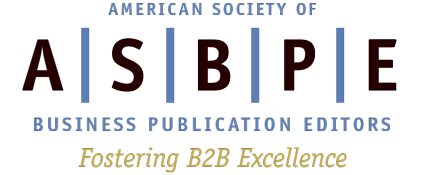
High-benefit headlines always have been a high-priority item for B2B editors. When it comes to digital, having an audience engagement message start right at the top is even more critical.
For the past few years, I’ve judged the Best Headline category in the AZBEE Awards and similar competitions. While many entries were on target in terms of delivery, a few others missed an occasional step. Based on previous reviews, I recently posted the following series of caveats on my Twitter page (@editsol):
- Hot headline is easier to write if lede’s first sentence expresses key story point within first ten words.
- Bad habit: basing head on first paragraph of PR announcement. There often is better angle further down.
- Perhaps hot headline you try to write doesn’t work because accompanying article should have been scrapped.
- News item’s first sentence must tell readers something new. Repeating all or part of the head is not how to do it.
- Some headline writing suffers from an “echo” that occurs when head and deck sound identical.
- If few of your articles require heads with numbers, make more assignments designed to fill in the void.
- Remember that subheads used to break up articles must have all attributes of main head. “Labels” not allowed.
- Headline variety is helpful attention-getter. Asking questions and pulling hot quotes from articles are two ways to do it.
- Design that limits main headline length to three or four words is a bummer! Editors must demand more leeway in their turn at bat.
- Good headlines tell readers what the writer discovered as opposed to what was covered. There is a difference!
Of the above items, the one competition entries goof on frequently is #6. This is a somewhat baffling observation, yes? Significant numbers demand reader engagement. Nevertheless, the number of heads including quantitative grabbers rarely exceeds five percent of total.
Another caveat not listed above – “cute” – often gets heavy flak when mentioned in a headline critique. Despite being nagged about this in previous competitions, some editors continue to embrace the temptation to engage in clever word play. This is especially self-destructive when the main headline uses three or four words. Surprisingly enough, attempts to be amusing rather than instructive regularly lead off some editorial columns. Instead, accompanying headlines should clearly reflect the author’s opinion. Achieving that goal requires at least eight to ten words.
Finally, despite previous blogs and face-to-face exhortations, I’ve been unable to convince some editors to abandon “source first, news last” lede sentences. This snafu’s most common form is beginning the article with a source’s very long title and company affiliation. Before you know it, readers may be dragged through over a dozen word s wondering when the real story starts!!
